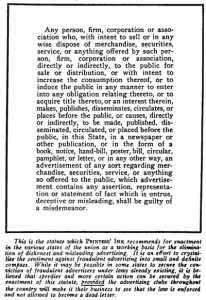In 1911, Harry D. Nims, was hired by Printers’ Ink magazine to write a model law to address the problem of deceptive advertising.[1] It read:

Any person, firm, corporation or association who, with intent to sell or in any wise dispose of merchandise, securities, service, or anything offered by such person, firm, corporation or association, directly or indirectly, to the public for sale or distribution, or with intent to increase the consumption thereof, or to induce the public in any manner to enter into any obligation relating thereto, or to acquire title thereto, or an interest therein, makes, publishes, disseminates, circulates, or places before the public, or causes, directly or indirectly, to be made, published, disseminated, circulated, or placed before the public, in this State, in a newspaper or other publication, or in the form of a book, notice, hand-bill, poster, bill, circular, pamphlet, or letter, or in any other way, an advertisement of any sort regarding merchandise, securities, service, or anything so offered to the public, which advertisement contains any assertion, representation or statement of fact which is untrue, deceptive or misleading, shall be guilty of a misdemeanor.
As envisioned by Printers’ Ink, the model statute would patch holes in existing state legislation. Then editor John Irving Romer argued that it was in the best interest of honest advertisers to adopt a stringent law punishing false advertising, and that the Advertising Clubs of America (then, a federation of over 100 local advertising clubs, now known as the American Advertising Federation) should prepare cases for prosecution by local authorities.[2] Romer opposed a new federal law, given that the recently amended mail fraud statute encompassed many types of fraud. As Romer and Nims saw it, the main problem was prosecutorial resources and the feeling among advertisers that it was not their responsibility to police unethical advertising when they encountered it.
Notice several interesting aspects of the statute:
- It is a criminal statute
- It is strict liability—the mens rea for the law goes to intent to publicize a product for sale not for an intent to deceive[3]
- It focuses liability on advertisers, not publications
The Printers’ Ink Statute is at core a self-regulatory model, because it assumes that enforcement would only occur at the request of an industry group. Could this model work today in the context of deceptive privacy policies or deceptive information practices?
Do you have due process concerns with the statute? Is it advantageous to make false advertising a misdemeanor or not?
The FTC could sue broadcasters, newspapers, and other publications for carrying misleading and illegal advertising. Should it do so? How about when publications carry ads for product categories that are notoriously deceptive, such as weight loss remedies?
[1] John Irving Romer, Legal Repression of Dishonest Advertising, 77(8) Printers’ Ink 66,68 (Nov. 23, 1911).
[2] The Progressive Era saw a proliferation of business ethics groups, several of which were focused upon truth in advertising in an attempt to raise the public perception of advertising and to professionalize its practice. Gabriel Abend explains that some of these groups evangelized business ethics as being good for business. The Moral Background: An Inquiry into the History of Business Ethics (2013).
[3] Many States Still Lack Protection of “Printers Ink” Model Statute: National Vigilance Committee to Work for its Adoption in States Where it is Not Now a Law, 121(4) Printers’ Ink 101 (Oct. 26, 1922)(“The Statute, as the reader will see, contains no qualifying phrase, such as “knowingly,” “with fraudulent intent,” or “calculated to mislead.” The inclusion of any such phrase most effectually takes the teeth out of the law and renders it inoperative. Many attempts have been made to ring changes on the word “knowingly” by opponents of the Model Statute…”)